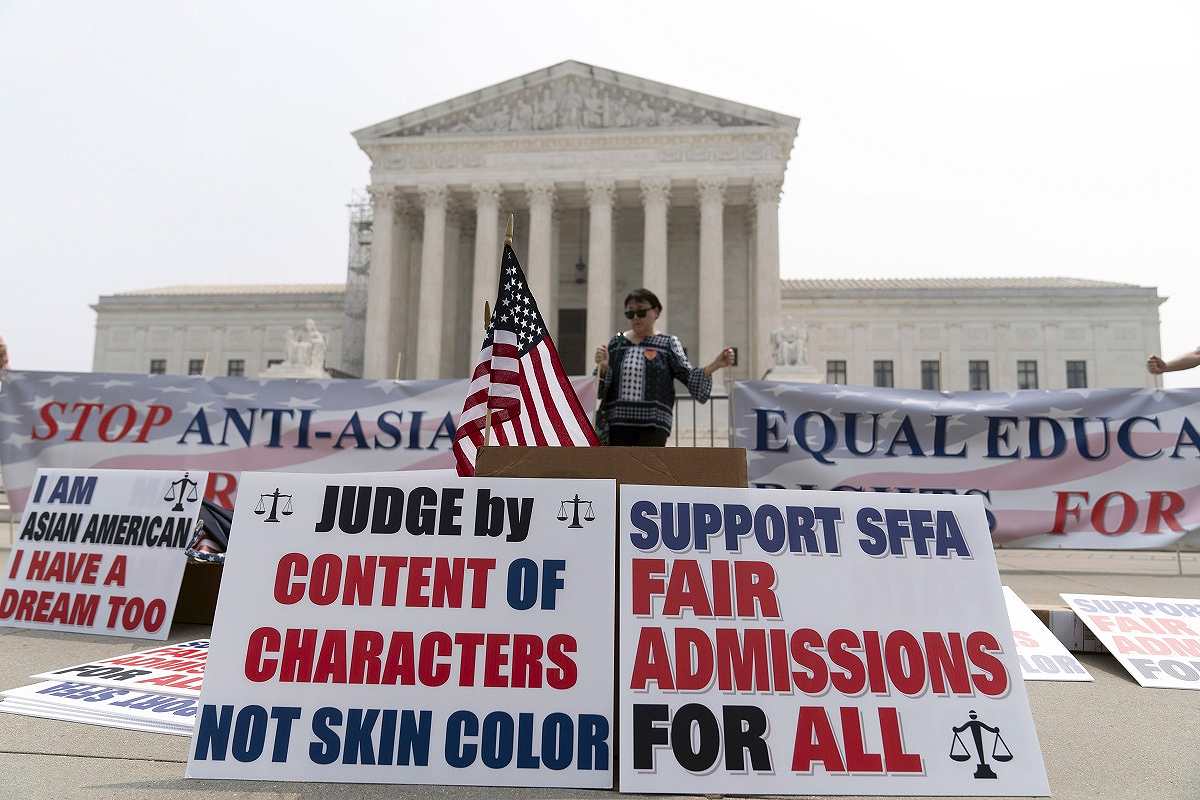Divided Supreme Court Outlaws Affirmative Action in College Admissions, Says Race Can’t Be Used

A person protests outside of the Supreme Court in Washington, Thursday, June 29, 2023.
10:23 JST, June 30, 2023
WASHINGTON (AP) — The Supreme Court on Thursday struck down affirmative action in college admissions, declaring race cannot be a factor and forcing institutions of higher education to look for new ways to achieve diverse student bodies.
The court’s conservative majority effectively overturned cases reaching back 45 years in invalidating admissions plans at Harvard and the University of North Carolina, the nation’s oldest private and public colleges, respectively.
The decision, like last year’s momentous abortion ruling that overturned Roe v. Wade, marked the realization of a long-sought conservative legal goal, this time finding that race-conscious admissions plans violate the Constitution and a law that applies to colleges that receive federal funding, as almost all do.
Those schools will be forced to reshape their admissions practices, especially top schools that are more likely to consider the race of applicants.
Chief Justice John Roberts said that for too long universities have “concluded, wrongly, that the touchstone of an individual’s identity is not challenges bested, skills built, or lessons learned but the color of their skin. Our constitutional history does not tolerate that choice.”
From the White House, President Joe Biden said he “strongly, strongly” disagreed with the court’s ruling and urged colleges to seek other routes to diversity rather than let the ruling “be the last word.”
Besides the conservative-liberal split, the fight over affirmative action showed the deep gulf between the three justices of color, each of whom wrote separately and vividly about race in America and where the decision might lead.
Justice Clarence Thomas — the nation’s second Black justice, who had long called for an end to affirmative action — wrote that the decision “sees the universities’ admissions policies for what they are: rudderless, race-based preferences designed to ensure a particular racial mix in their entering classes.”
Justice Sonia Sotomayor, the court’s first Latina, wrote in dissent that the decision “rolls back decades of precedent and momentous progress.”
Both Thomas and Sotomayor, the two justices who have acknowledged affirmative action played a role in their admissions to college and law school, took the unusual step of reading summaries of their opinions aloud in the courtroom.
In a separate dissent, Justice Ketanji Brown Jackson — the court’s first Black female justice — called the decision “truly a tragedy for us all.”
Jackson, who sat out the Harvard case because she had been a member of an advisory governing board, wrote, “With let-them-eat-cake obliviousness, today, the majority pulls the ripcord and announces ‘colorblindness for all’ by legal fiat. But deeming race irrelevant in law does not make it so in life.”
The vote was 6-3 in the North Carolina case and 6-2 in the Harvard case. Justice Elena Kagan was the other dissenter.
Biden, who quickly stepped before cameras at the White House, said of the nation’s colleges: “They should not abandon their commitment to ensure student bodies of diverse backgrounds and experience that reflect all of America,” He said colleges should evaluate “adversity overcome” by candidates.
In fact, an applicant for admission still can write about, and colleges can consider, “how race affected his or her life, be it through discrimination, inspiration or otherwise,” Roberts wrote.
But the institutions “may not simply establish through application essays or other means the regime we hold unlawful today,” he wrote.
Presidents of many colleges quickly issued statements affirming their commitment to diversity regardless of the court’s decision. Many said they were still assessing the impact but would follow federal law.
“Harvard will continue to be a vibrant community whose members come from all walks of life, all over the world,” school President Lawrence Bacow said in a statement.
President Reginald DesRoches of Rice University in Houston said he was “greatly disappointed” by the decision but “more resolute than ever” to pursue diversity. “The law may change, but Rice’s commitment to diversity will not,” he said in a campus message.
Former Presidents Donald Trump and Barack Obama offered starkly different takes on the high court ruling. The decision marked “a great day for America. People with extraordinary ability and everything else necessary for success, including future greatness for our Country, are finally being rewarded,” Trump, the current Republican presidential frontrunner, wrote on his social media network.
Obama said in a statement that affirmative action “allowed generations of students like Michelle and me to prove we belonged. Now it’s up to all of us to give young people the opportunities they deserve — and help students everywhere benefit from new perspectives.”
The Supreme Court had twice upheld race-conscious college admissions programs in the past 20 years, including as recently as 2016.
But that was before the three Trump appointees joined the court. At arguments in late October, all six conservative justices expressed doubts about the practice, which had been upheld under Supreme Court decisions reaching back to 1978.
Lower courts also had upheld the programs at both UNC and Harvard, rejecting claims that the schools discriminated against white and Asian American applicants.
The college admissions disputes were among several high-profile cases focused on race in America, and were weighed by the conservative-dominated, but most diverse court ever. Among the nine justices are four women, two Black people and a Latina.
The justices earlier in June decided a voting rights case in favor of Black voters in Alabama and rejected a race-based challenge to a Native American child protection law.
The affirmative action cases were brought by conservative activist Edward Blum, who also was behind an earlier challenge against the University of Texas as well as the case that led the court in 2013 to end use of a key provision of the landmark Voting Rights Act.
Blum formed Students for Fair Admissions, which filed the lawsuits against both schools in 2014.
The group argued that the Constitution forbids the use of race in college admissions and called for overturning earlier Supreme Court decisions that said otherwise.
Roberts’ opinion effectively did so, both Thomas and the dissenters wrote.
The only institutions of higher education explicitly left out of the ruling were the nation’s military academies, Roberts wrote, suggesting that national security interests could affect the legal analysis.
Blum’s group had contended that colleges and universities can use other, race-neutral ways to assemble a diverse student body, including by focusing on socioeconomic status and eliminating the preference for children of alumni and major donors.
The schools said that they use race in a limited way, but that eliminating it as a factor altogether would make it much harder to achieve a student body that looks like America.
At the eight Ivy League universities, the number of nonwhite students increased from 27% in 2010 to 35% in 2021, according to federal data. Those men and women include Asian, Black, Hispanic, Native American, Pacific Islander and biracial students.
Nine states already prohibit any consideration of race in admissions to their public colleges and universities. The end of affirmative action in higher education in California, Michigan, Washington state and elsewhere led to a steep drop in minority enrollment in those states’ leading public universities.
The other states are: Arizona, Florida, Georgia, Nebraska, New Hampshire and Oklahoma.
In 2020, California voters easily rejected a ballot measure to bring back affirmative action.
A poll last month by The Associated Press-NORC Center for Public Affairs Research showed 63% of U.S. adults say the court should allow colleges to consider race as part of the admissions process, yet few believe students’ race should ultimately play a major role in decisions. A Pew Research Center survey released last week found that half of Americans disapprove of considerations of applicants’ race, while a third approve.
The chief justice and Jackson received their undergraduate and law degrees from Harvard. Two other justices, Neil Gorsuch and Kagan, went to law school there, and Kagan was the first woman to serve as the law school’s dean.
Every U.S. college and university the justices attended, save one, urged the court to preserve race-conscious admissions.
Those schools — Yale, Princeton, Columbia, Notre Dame and Holy Cross — joined briefs in defense of Harvard’s and UNC’s admissions plans.
Only Justice Amy Coney Barrett’s undergraduate alma mater, Rhodes College, in Memphis, Tennessee, was not involved in the cases.
"News Services" POPULAR ARTICLE
-

American Playwright Jeremy O. Harris Arrested in Japan on Alleged Drug Smuggling
-

Japan’s Nikkei Stock Average as JGB Yields, Yen Rise on Rate-Hike Bets
-

Japan’s Nikkei Stock Average Licks Wounds after Selloff Sparked by BOJ Hike Bets (UPDATE 1)
-

Japan’s Nikkei Stock Average Buoyed by Stable Yen; SoftBank’s Slide Caps Gains (UPDATE 1)
-

Japanese Bond Yields Zoom, Stocks Slide as Rate Hike Looms
JN ACCESS RANKING
-

Keidanren Chairman Yoshinobu Tsutsui Visits Kashiwazaki-Kariwa Nuclear Power Plant; Inspects New Emergency Safety System
-

Imports of Rare Earths from China Facing Delays, May Be Caused by Deterioration of Japan-China Relations
-

University of Tokyo Professor Discusses Japanese Economic Security in Interview Ahead of Forum
-

Tokyo Economic Security Forum to Hold Inaugural Meeting Amid Tense Global Environment
-

Japan Pulls out of Vietnam Nuclear Project, Complicating Hanoi’s Power Plans


























